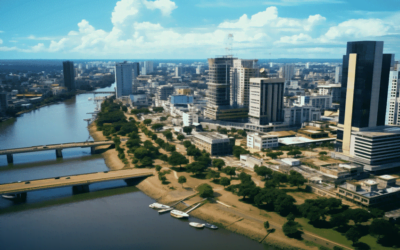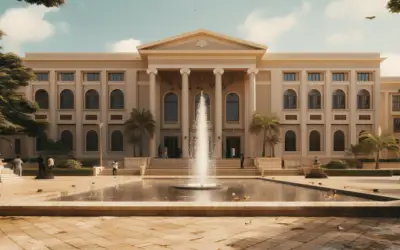Hey there, if you’re reading this, chances are you’ve got some burning questions about Mexico drone laws. I get it; the world of drone regulations can be a bit of a maze.
Whether you’re a traveler, a budding drone enthusiast, or an entrepreneur with a keen eye for those cinematic aerial shots, understanding the ins and outs of Mexico’s drone laws is crucial. I’ve been there, and I know that having the right information can make or break your drone adventures.
Well, the good news is that I’ve delved into the intricate web of Mexico’s drone regulations. You see, I’m just as passionate about drones as you are.
In my quest for clarity, I’ve sifted through official documents, read up on the experiences of fellow drone users, and explored the latest updates.
I wanted to ensure I could provide you with the most up-to-date and reliable information. So, consider me your guide to navigating the world of Mexico’s drone laws.
Now, if you’re eager to uncover the answers to your questions about Mexico’s drone laws, you’re in the right place. In the following sections, I’ll lay it all out for you.
We’ll cover the registration process, operational guidelines, permit requirements, and even some unique insights that can help you make the most of your drone experiences in Mexico. So, why wait? Read on, and let’s get those drone adventures soaring while staying on the right side of the law
General Regulations

Navigating the vast world of drone laws in Mexico, I’ve found that understanding the general regulations is where it all begins. These rules set the stage for safe and responsible drone usage.
Registration and Licensing
Now, let’s dive into one of the first crucial aspects: drone registration and licensing in Mexico. To embark on your drone adventures here, you’ll need to start by complying with these essential requirements.
The requirement for drone registration with the Mexican Federal Aviation Administration (AFAC)
So, you’ve got your shiny new drone, and you’re ready to take flight in the vibrant skies of Mexico. But before you do, there’s an essential step you can’t skip: registering your drone with the Mexican Federal Aviation Administration, or AFAC. This registration process is a key part of ensuring that your drone use is in accordance with the law. It’s like getting your drone a passport to explore Mexican airspace legally.
The need for proof of registration to obtain authorization
Once you’ve registered your drone, the next piece of the puzzle is obtaining authorization for your flights. This authorization is your green light to take off and explore the stunning landscapes or capture that perfect aerial shot.
However, here’s the catch: to get that authorization, you’ll need to show proof of your drone’s registration with AFAC. Think of it as showing your ID to enter a restricted area; this is your proof that you’re playing by the rules.
Drone Weight Limits
Now, let’s talk about the weight of your drone, a factor that can significantly impact the regulations you need to follow in Mexico.
The distinction between drones under 250 grams and those over 250 grams:
In the world of drones, weight matters. Mexico makes a clear distinction between drones that weigh under 250 grams and those that tip the scales at over 250 grams.
It’s like categorizing small cars and larger SUVs; the rules are different depending on the weight class. For drones under 250 grams, the regulations are relatively light, but once you cross that threshold, additional requirements come into play.
Registration and permit requirements based on weight
Here’s where the weight of your drone comes into play. Drones under 250 grams enjoy some flexibility, with fewer registration and permit requirements.
It’s like the difference between a moped and a motorcycle; lighter drones face fewer hurdles. However, for those drones tipping the scales at over 250 grams, you’ll need to roll up your sleeves and go through the registration process. It’s all about ensuring safety while enjoying your drone to the fullest.
Compliance with Municipal Authorities
When it comes to navigating the intricacies of Mexico’s drone laws, we’re diving into a realm where local authorities play a vital role in ensuring safe and responsible drone usage.
The possibility of needing additional approvals from local authority
As you spread your wings in the world of drone exploration, you’ll come to realize that the rules can vary not only at the national level but also on a local scale. Yes, that’s right, local authorities might have a say in your drone adventures.
It’s akin to needing a permit to host a neighborhood block party; sometimes, your drone activities may require a nod from local officials. So, while you’ve got the national regulations covered, remember to check in with the folks at the local level to ensure you’re following all the rules to the letter. It’s all part of the journey to drone exploration in Mexico.
Also Read Mauritius Drone Laws ]year]
Operational Guidelines

Now, let’s delve into the practical side of drone laws in Mexico, where operational guidelines define how high you can soar and how close you can fly to people.
Altitude and Distance Restrictions
Picture this: you’re high above the Mexican landscape, controlling your drone with precision. But to do this legally and safely, you’ll need to be well-versed in altitude and distance restrictions.
The maximum altitude for drone flights (150 meters above sea level)
Mexico’s skies are vast, but there’s a limit to how high your drone can roam. Regulations dictate that you should maintain a maximum altitude of 150 meters above sea level. It’s all about striking the right balance between enjoying those breathtaking aerial views and ensuring the safety of airspace for all.
Minimum distance from people (50 meters)
Ever wondered how close you can get to people without crossing the line? In Mexico, it’s recommended to maintain a horizontal distance of at least 50 meters from individuals who aren’t directly involved in your drone operation. It’s like giving folks their own little bubble of personal space, ensuring that your drone adventures don’t intrude on their world.
Nighttime Restrictions
Now, let’s switch gears and talk about flying drones when the sun dips below the horizon.
General prohibition on flying drones at night
As the night falls and the stars emerge, drone enthusiasts might be tempted to take flight in the moonlight. But here’s the scoop: Mexico generally prohibits flying drones at night. It’s like an unwritten rule of the nocturnal skies.
However, don’t be disheartened; exceptions exist for those who are prepared to illuminate their drones and ensure they’re visible from all angles.
Exceptions and regulations for nighttime use, including the use of lights:
There’s a solution for those who crave those nighttime flights. Mexico has regulations in place for flying your drone after dark, provided you equip it with the right lights to make it visible. It’s all about ensuring that you don’t cross paths with other aircraft in the dark.
So, if you’ve got your heart set on those mesmerizing night flights, just make sure your drone is lit up like a shooting star.
Restricted Areas
Now, let’s navigate the regulatory maze when it comes to where you can or can’t fly your drone in Mexico. These restricted areas are essential to understand to ensure safe and responsible drone usage.
Prohibitions on flying over urban areas, groups of people, and private property without permission
When you’re up there in the sky with your drone, there are some places you should steer clear of. Mexico’s regulations frown upon flying over urban areas, groups of people, and private property without proper permission. It’s all about respecting personal space and privacy, just like you wouldn’t want someone buzzing over your own backyard without asking, right?
Restrictions on flying near airports and military installations
Mexico takes its airspace around airports and military installations quite seriously. When your drone is in the vicinity of these areas, it’s important to understand the restrictions in place. It’s like respecting the no-entry zones around critical infrastructure.
So, whether you’re capturing footage near an airport or trying to get a glimpse of a military installation from above, remember that some places are off-limits, and for good reason.
Also Read: Mauritiana Drone Laws 2024
Flying Drones in Mexico

Let’s get down to the nitty-gritty of how to fly your drone in Mexico, covering the permit process and the intricacies of managing your drone’s batteries during flights.
Step-by-Step Permit Process
Now, to set your drone soaring legally in Mexico, you’ll need to tackle the permit process. It might sound daunting, but I’ve got the steps to simplify the journey.
Filling out the necessary forms for registration
The first step on your drone journey in Mexico involves a bit of paperwork. You’ll need to fill out the required forms for drone registration with the Mexican Federal Aviation Administration (AFAC). Think of it as the initial checkpoint where you officially introduce your drone to the Mexican airspace.
Providing identification and ownership documentation
To complement the registration process, you’ll need to provide identification and documentation proving ownership or possession of your drone. It’s like ensuring you have your driver’s license and car registration while driving; here, you need to show that you’re the rightful owner of your flying companion.
Waiting for approval and potential contact from the agency
With the paperwork and documentation submitted, it’s time to play the waiting game. AFAC will review your registration and may contact you for any additional clarifications or to resolve any issues. It’s a bit like waiting for that exciting package to arrive at your doorstep; in this case, your package is the official approval to take your drone to the skies legally.
Handling Drone Batteries on Flights
Now, let’s discuss how to handle your drone batteries when it’s time to take off.
Carrying drones in carry-on luggage
When it’s time to board your flight to Mexico with your drone, remember to keep it close. According to international aviation regulations, it’s advisable to carry your drone in your carry-on luggage. It’s all about ensuring that your drone and its batteries are under your watchful eye, just like you would with your precious electronics.
Avoiding placing drone batteries in checked baggage
Here’s an important piece of advice: never place your drone batteries in your checked baggage. Airlines have strict rules when it comes to lithium-ion batteries, which are commonly used in drones.
These batteries are considered “dangerous goods,” and there are extensive rules in place to ensure their safe transport. Placing them in your checked baggage can lead to issues, from fines to seizure. So, keep those batteries in your carry-on bag, just like the pros do.
Also Read: Marshall Islands Drone Laws 2024
Recent Updates for Clarity

In the ever-evolving world of drone regulations, staying informed is key. Let’s explore recent updates that can provide clarity when navigating Mexico’s drone laws.
Introduction of reader-provided links for clearer regulations
I recently received some valuable assistance from a reader who shared links to essential resources for understanding drone regulations in Mexico.
These links, from the official Agencia Federal de Aviación Civil (AFAC) website, offer a wealth of information on RPAS (drones) and the necessary requirements.
These resources can be a game-changer for anyone looking to ensure they’re following the rules to the letter. So, a big shoutout to that reader for helping us all gain a better grasp of the regulations!
The importance of understanding the official documents, even if in Spanish
While the official documents from AFAC are primarily in Spanish, don’t let the language barrier deter you. It’s crucial to dive into these documents to grasp the finer details of drone regulations in Mexico.
Even if Spanish isn’t your forte, tools like Google Translate can be your trusty sidekick. Understanding these documents is like deciphering the treasure map to hassle-free drone exploration in Mexico. So, don’t be daunted by the language; take the time to translate and comprehend, and you’ll navigate the regulations like a pro.
Also Read: Malta Drone Laws 2024
Final Thoughts on Mexico Drone Laws

As we wrap up this journey through the intricacies of Mexico’s drone laws, it’s essential to highlight a few key takeaways that can make your drone adventures in this beautiful country a breeze.
First and foremost, I can’t stress enough how crucial it is to follow Mexican drone laws diligently. These regulations aren’t just about paperwork and formalities; they’re designed to ensure safety for all, from fellow sky enthusiasts to people on the ground. Compliance with these laws isn’t just a legal requirement; it’s a commitment to responsible and safe drone usage.
If you’re planning to explore Mexico’s stunning landscapes, capture breathtaking vistas, or simply enjoy the thrill of drone flight, I strongly encourage you to dive into the regulations.
Take the time to understand the dos and don’ts of Mexican airspace. It’s a bit like studying a new map before embarking on an exciting adventure; knowing the terrain will make your journey smoother and more enjoyable.
Mexico is a land of incredible opportunities for both tourists and entrepreneurs in the drone industry. The rich culture, diverse landscapes, and vibrant cities create the perfect backdrop for drone adventures.
So, whether you’re a traveler seeking that perfect aerial shot or a business-minded drone enthusiast exploring new possibilities, Mexico has something to offer you. Embrace the regulations, and you’ll uncover a world of breathtaking experiences and entrepreneurial prospects in this dynamic country.
Frequently Asked Questions on Mexico Drone Laws
Do I need a permit to fly a drone in Mexico?
Yes, in Mexico, you typically need a permit to fly a drone, especially if your drone weighs more than 250 grams. Even as a foreigner, you are required to register your drone with the Mexican Federal Aviation Administration (AFAC) and obtain a permit for recreational or commercial use.
What are the weight restrictions for drones in Mexico?
Mexico distinguishes between drones weighing under 250 grams and those over 250 grams. Drones under 250 grams do not need to be registered, while those over 250 grams require registration and a permit, irrespective of whether you’re a Mexican citizen or a foreign visitor.
Can I fly my drone at night in Mexico?
In general, Mexico prohibits flying drones at night. However, there are exceptions and regulations for nighttime use, which include equipping your drone with lights to ensure visibility from all directions.
What are the restrictions on flying over people or private property in Mexico?
Mexico’s drone laws prohibit flying over urban areas, groups of people, and private property without obtaining proper permission from property owners or authorities. Respecting these restrictions is essential to protect people’s privacy and safety.
Where can I find official information on Mexico’s drone regulations, even if I don’t speak Spanish?
While the official documents may primarily be in Spanish, the Agencia Federal de Aviación Civil (AFAC) website provides essential information on RPAS (drones) and the requirements for flying them in Mexico. You can use translation tools like Google Translate to navigate the information, ensuring that you have a solid understanding of the regulations.













